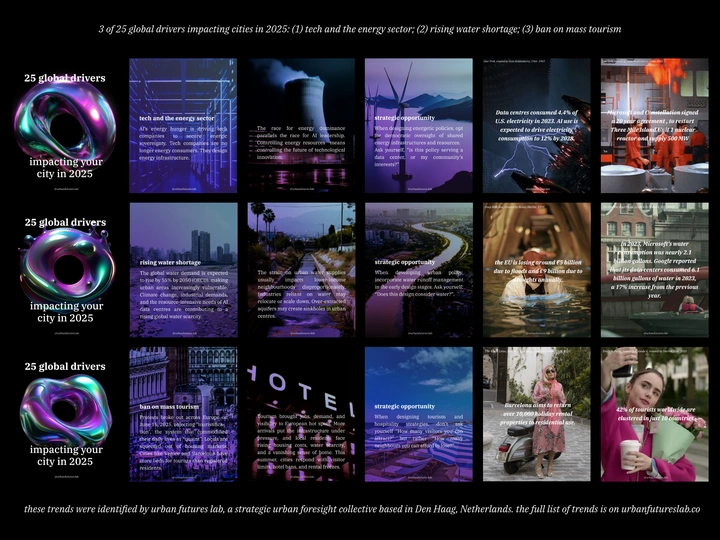25 Signals of the Urban Tomorrow

Ben Drusinksy
Urban Futures Lab founded by Julia and Ben in 2024 in The Hague, Netherlands. We worked as architects and urban designers and were frustrated with the short-sightedness of the practice. We started urban futures lab to understand where cities are going, and help cities prepare.
Julia is an architect and urban designer completing her PhD at TU Delft. She has facilitates various workshops, including hosting sessions at Placemaking Week Europe. Julia's research investigates how communities can collectively imagine urban futures.
Ben is an architect and computational designer completing his PhD at TH Köln. He hosted talks and workshops at Creative Coding Utrecht and V2 Creative Coders Rotterdam on using technology for art, and taught a semianr at KISD (TH Köln) encouraging students to hack systems through speculative design.
We aim to steer spatial practices toward responsible regenerative principles. By detecting signals before they become crises, we embody the anticipatory thinking essential for sustainable urbanism.
Urban Futures Lab detects invisible signals reshaping European cities, applying methodologies from the fashion world to urban space. We make visible the hidden forces driving urban futures beyond the expected, and enable communities to anticipate multiple possible futures, building resilience through preparation. We mapped 25 global drivers across six sectors: (1) economy, (2) society, (3) urbanisation, (4) environment, (5) technology, and (6) energy. We track weak signals across sectors before they manifest in policy or space. In 2026, we'll prototype 26 future scenarios from these trends through collaborative making sessions.
We apply rapid-response methodologies from fashion forecasting, trend identification, and lifecycle analysis to urban systems. We explore emerging signals across sectors, then prototype how they might manifest spatially through collaborative making sessions with local experts and communities. In these participatory prototyping sessions, players imagine what these futures entail. Our approach broadens the scope of possibility, enabling communities to imagine and prepare for multiple scenarios.
Our quarterly Amsterdam meetups bring together urban experts to decode emerging signals. We've facilitated prototyping workshops at Placemaking Week Europe (Rotterdam, 2024) and presented our methodology at CDFAM conference and AMS Institute (Amsterdam, 2025). We aim to position trend analysis as a collective practice.
In collaboration with LINA, we propose investigating how the 25 drivers manifest in a specific spatial context. Through local prototyping sessions with the local communities, we will generate exhibitions displaying alternative urban scenarios and talks sharing insights about managing uncertainty. This allows us and the audiences to explore how global trends manifest locally within the broader context of urban transformation. Our presentations and talks democratize futures thinking, making trend analysis accessible to all.